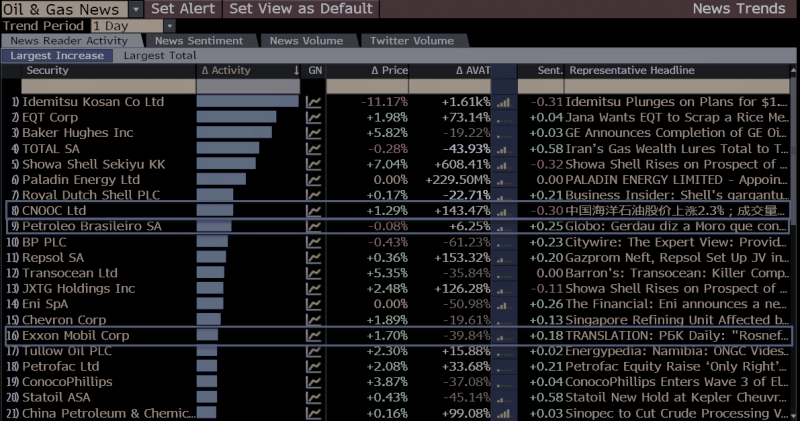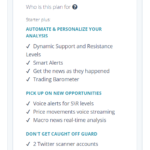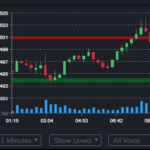What is the most common software that people associate with trading or financial services in general – the Bloomberg Terminal. And they do so for good reasons. The billion- dollar enterprise software offers almost everything there is to know about a stock, index or commodity. So how does BetterTrader size up to the best? And why should people use it?
How Should We Interpret the News?
The most important task of a trader is to predict the market’s reactions to new developments in the world (aka news), and it is therefore crucial for a trading software to aid traders in that process. Let’s first take a look at how Bloomberg presents a piece of news in relation to the market:
We can see that Bloomberg presents all the available information as is – a news item’s headline, resulting price changes, volumes and market sentiments. For an investor, who assumes that the news has been priced in by the market, this presentation is perfect; it tells them exactly what has happened, and even gives the option to further research the news by reading a Bloomberg article.
For a trader, however, there is still much left to be desired. They still need to do a lot of further research to predict what will happen next: how big of a surprise is the news? What happened in similar situations in the past? Which prices will be most affected? While these information can be extracted from the vast reserve of metrics, charts and research reports on Bloomberg, the time to conduct such research is so long compared to the time horizon of day trading that traders often just resort to relying on their own experience. This presents two problems. Firstly, good experience is not something that every trader has accumulated. Secondly, even the best trader cannot remember every market reaction ever, so their trading decisions can be sometimes irrational.
Let’s now look at how BetterTrader presents a news item, say a weaker than expected Housing Starts release.
BetterTrader presents not only what just happened, but also a news item’s impact and historical context. Furthermore, because it is designed specifically for traders, it provides a list of possible trade ideas.
The “Trade Ideas” tab fills in exactly what was missing in Bloomberg, it tells traders the prices most likely to be affected by weak Housing Starts, the time horizon on these impacts and what happened historically. If an experienced trader is not satisfied with these simple results, they could go to the BackTester to see how exactly they are generated and test scenarios based on their own assumptions. Equipped with these tools, a trader will no longer be overwhelmed by information and be able to make statistically sound trading decisions in short time frames.
How about Prices?
Although news drive the market, the resulting prices are what determine a trade’s success, so understanding the meaning of current prices is equally important to a trader and a trading software. At first glance, Bloomberg Terminal and BetterTrader have very similar presentations of prices; both are filled with line charts, ranges, volumes and volatility metrics. However, they each have unique additional tools that are key to understanding prices in different situations.
Bloomberg, with its vast resources, is filled with information about the underlying value of a specific security, contract or index. Take public equity, or stock, as an example, Bloomberg provides a company’s earnings releases, equity research reports, valuation multiples and operating ratios. An investor or investment banker can easily use Bloomberg to build models to determine the price range of a stock and if it is undervalued or overvalued.
While market prices are tied to the value of underlying assets in the long term, the realization of underlying value is an impossible expectation in the short time horizons that traders work in. What instead drives the market in the short run is greed and fear, or the market’s perception of risks and rewards.
To understand this crucial aspect of prices in the short run, BetterTrader has a unique feature called “Risk on-Risk off” (RORO), which gauges the market’s current risk preference by measuring capital flow between different asset classes.
Equipped with the market’s perception of risks and rewards, a trader will be able to be more aggressive or conservative in different trades.
The Key Takeaway: Both the Bloomberg Terminal and BetterTrader are powerful tools for working with the markets, but they are designed with different time horizons in mind. An investor, who wants to appreciate their capital in the long run and avoid short-term volatility, is the ideal user of Bloomberg; a trader, who seeks to take advantage of the market’s volatility, is better off using BetterTrader.
To learn more about Trade Ideas and the BackTester, check out our blog post on it. To learn more about RORO, you can read this other blog post.


















